Maasai Chess
NOTE: this game is still under test. Please do not make it public for the moment.
The Maasai are a people living in East Africa, Kenya and Tanzania, near the Great Lakes region. They are famous for their distinctive customs and colorful dress. This large chess variant is dedicated to this great people.
The board is the dozenal 12x12 square battlefield, like for Metamachy and Zanzibar games. The pieces from Metamachy and Zanzibar-S are used here again, with a small and necessary difference for what concerns the Pawns and the Princes, which is explained below. The Sorceress and the Duchess are borrowed from the giant board of Terachess-II.
The setup occupies four full ranks for each player, which gives 48 pieces in each side. There are 20 different types of pieces, including Pawns and Soldiers.
Each player has: 1 King, 1 Queen, 1 Eagle, 1 Lion, 1 Rhinoceros, 1 Buffalo, 1 Sorceress, 1 Duchess, 2 Princes, 2 Bishops, 2 Knights, 2 Camels, 2 Rooks, 2 Cannons, 2 Elephants, 2 Giraffes, 2 Crocodiles, 2 Machines, 8 Soldiers (Maasai) and 12 Pawns.
Like for its parents games Metamachy and Zanzibar, there is a choice of different starting setups. Black chooses the setup and White makes the first move.
The goal is to checkmate the opposing King.
Setup
At the beginning Pawns, Maasai and all pieces which come as pairs (Elephants, Cannons, Rooks, Camels, Knights, Giraffes, Bishops, Crocodiles, Princes, Machines) are placed on the board as follows for each player:
- 1st row: Cannon / Camel / Giraffe / Crocodile / . / . / . / . / Crocodile / Giraffe / Camel / Cannon
- 2nd row: Elephant / Rook / Knight / Bishop / . / . / . / . / Bishop / Knight / Rook / Elephant
- 3rd row: 4 x Pawns / Prince / Machine / Machine / Prince / 4 x Pawns
- 4th row: 4 x Soldiers / 4 x Pawns / 4 x Soldiers
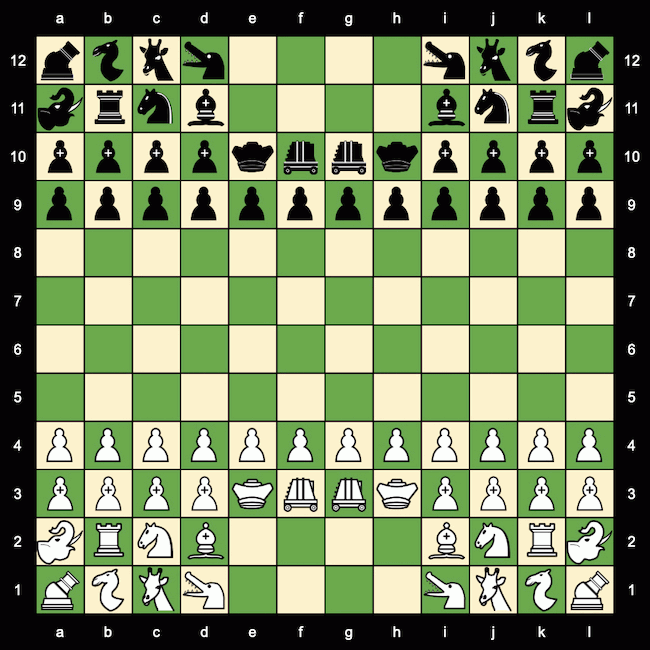
Then, Black freely decides where to place his King on one central square of the first or second row, f12, g12, f11 or g11, then his 7 "single" pieces, Queen - Eagle - Lion - Rhinoceros - Buffalo - Duchess - Sorceress on the remaining free 7 squares on the center of the board (e11, f11, g11, h11, e12, f12, g12, h12) in whichever order.
Then, White put his pieces symmetrically in mirror (if Black King is on f11, White King goes on f2) and makes the first move.
It can be demonstrated that it exists more than 10,000 different starting positions:
- Black King can placed on f11 or 12, the a choice of 2 positions.
- Then, the Queen has a choice of 7 positions on the first or second row.
- Then, the Eagle has a choice of 6 remaining positions
- The Lion has a choice of 5 remaining positions
- The Rhinoceros has a choice of 4 positions
- The Buffalo has a choice of 3 positions
- The Duchess has a choice of 2 positions
- The Sorceress goes on the last remaining free square on the first row.
- 2x7x6x5x4x3x2 = 10080
All positions where the Black King is placed on f12 or g11 are completely equivalent by symmetry and are, therefore, not accounted for.
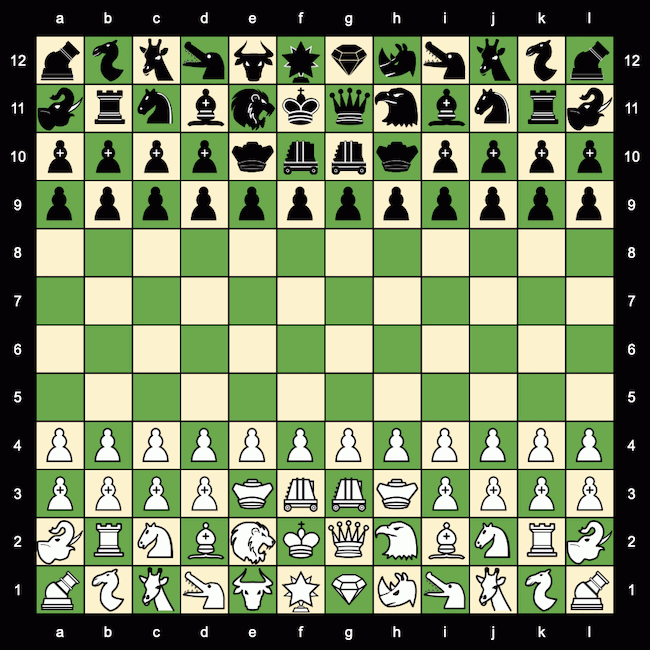
Diagrams made with the fantastic Chess Board Painting Tools provided by Musketeer Chess
Pieces
King: moves 1 step in every (8) directions on a not attacked square. The King is in check if it is attacked by one or several enemy pieces. It is forbidden to play a move letting his King in check.
There is no castling in Maasai Chess. At his first move, the King may jump to a free square at two squares' distance. For instance, from f2, it can jump to d1, d2, d3, d4, e4, f4, g4, h4, h3, h2 or h1). It does not matter if the square jumped over is occupied or not; however, the jump is forbidden if that intermediate square is threatened by an enemy piece. When jumping like a Knight, at least one of the two intermediate squares must be free of threat (e.g., if jumping from f2 to h3, either g2 or g3 must not be under attack). The King's jump is not permitted if the King is in check. This rule, which was once prevalent in medieval European chess, replaces castling. Identical to Metamachy.
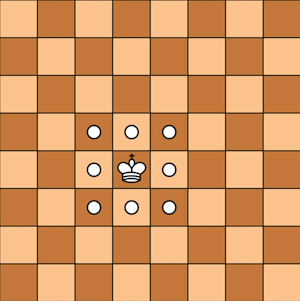
Queen: slides to any square along the file, the rank or a diagonal on which it stands. Identical to standard chess.
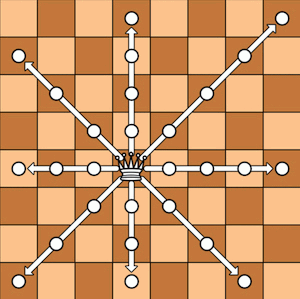
Rook: moves to any square along the file or the rank on which it stands. Identical to standard chess (except there is no castling)
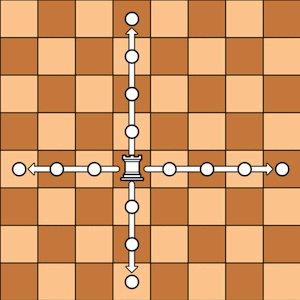
Bishop: slides to any square along a diagonal on which it stands. Identical to standard chess
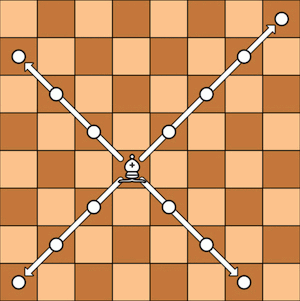
Knight: a (2,1) jumper, it jumps to the opposite square of a 2x3 rectangle. No matter what the intermediate square contains. Identical to standard chess

Pawn: it can move straight forward one, or two square from its starting position on the board, without capturing. It captures one square diagonally forward. Identical to standard chess and different from Metamachy

Soldier: it can move and capture straight forward one square. It can make an initial non-capturing and non-jumping move two squares from its starting position. Like in Xiangqi (Chinese chess), it gets the capability of moving and capturing on square side-ward as soon as it penetrates the opposing half of the board.
Eagle: moves one square diagonally and then, slides away of an indefinite number of squares vertically or horizontally. It is authorized to go only one square diagonal. It can not jump and the unobstructed path must start with the diagonal movement. This piece is almost as powerful as the Queen and is inspired by the Giraffe from Tamerlane's Chess and the Aanca (a mythical giant bird preying elephants, mistaken for a gryphon) from Alfonso X's Grande Acedrex. Identical to Metamachy.
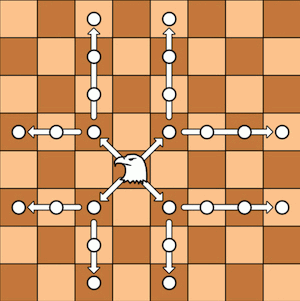
Rhinoceros: moves one square vertically or horizontally and then, slides away of an indefinite number of squares diagonally. It is authorized to go only one square in line or column. It can not jump and the unobstructed path must start with the orthogonal movement. This piece is inspired by the Unicorn of medieval Grande Acedrex. It is a counterpart of the Eagle. It is now called Manticore on the chessvariants pages. Identical to Zanzibar.
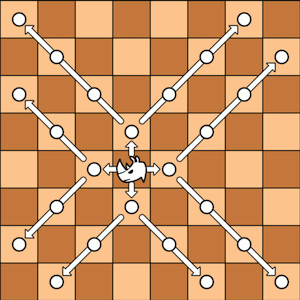
Lion: moves as a King (a single step move in any direction as Wazir or Ferz), or may jump to a position two squares away, jumping in any orthogonal (Dabbaba) or diagonal (Alfil) directions, or jumping as a Knight. (Inspired by Chu Shogi, the most popular variant of the Japanese Chess, where the Lion has the same range but is more dreadful as it can move twice in a turn). Identical to Metamachy.

Camel: a (3,1) jumper, it jumps to the opposite square of a 2x4 rectangle, like an extended Knight. No matter what intermediate squares contain. Note that it always stays on the same color of square. A well known piece from medieval Muslim great Chess like Tamerlane's Chess. Identical to Metamachy

Giraffe: a (3,2) jumper, it jumps to the opposite square of a 3x4 rectangle, like an extended Knight. No matter what intermediate squares contain. Note that it always changes the same color of its square. That piece is found in Alfonso X's Grant Acedrex (but its move has been rendered differently by 20th century historians). The same pattern, but with a non-jumping move, is found in Janggi, Korean Chess, for the Elephant. Under the name of Zebra, it is also a fairy piece used by problemists for compositions. Identical to Zanzibar.
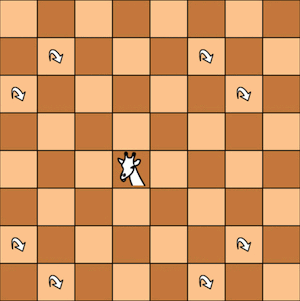
Buffalo: combines the leaps of the Knight (2,1), the Camel (3,1) and the Giraffe (3,2). Identical to Zanzibar.
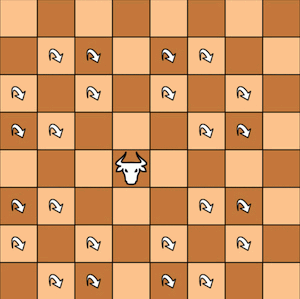
Cannon: exactly as in Xiangqi. The Cannon moves without taking like a Rook, but it takes by going in a straight horizontal and vertical line and jumping over exactly one piece. When a Cannon takes a piece, there must be exactly one piece between the original and final square of the Cannon's move - this piece may be of either color. This is identical to the move of the Cannon in Shako and Metamachy.
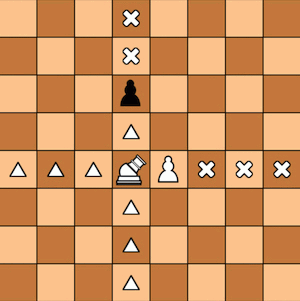
Crocodile: it is the diagonal counterpart of the Xiangqi's Cannon. It moves like a Bishop (which was named Crocodile in Grant Acedrex) and needs an intermediate piece between itself and its victim to capture it. The Crocodile jumps the intermediate and takes the victim on its square. The intermediate is left unaffected. Also known as Vao by problemists. Identical to Zanzibar.
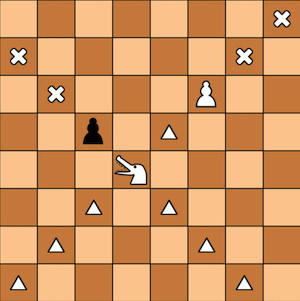
Machine: it is an orthogonal counterpart of the Elephant as it moves 1 or 2 squares orthogonally, jumping over the first square if it is occupied. Then, it combines the moves of old Dabbaba and Wazir found in ancient Muslim Chess variants. The word Dabbaba designated a siege machine at war in Arabic, hence the name given for this piece. Identical to Zanzibar.
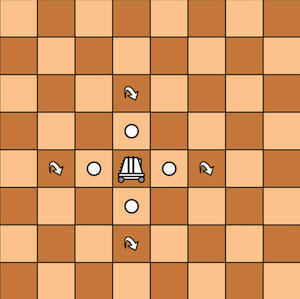
Elephant: exactly as in Shako and Metamachy. It moves one or two squares diagonally. When an Elephant moves two squares, no matter what intermediate squares contain. Note that it always stays on the same color of square. The Elephant moves as the combined Alfil and Ferz from Shatranj, two pieces which were also present in mediaeval Chess and have disappeared with the birth of modern moves for the Bishop and the Queen.

Prince: a non-royal King who moves and captures one square in any direction, but without being hindered by check. It has been inspired by medieval games like the Courier chess , an old chess variant, played in Germany, where it is called "Man". Like the Pawn, he can also move, without jumping, to a second empty square straight ahead from its starting rank on the board.

Sorceress: it moves like a Queen and needs an intermediate piece between itself and its victim to capture it. The Sorceress jumps the intermediate and takes the victim on its square. The intermediate is left unaffected. Like the Queen is Bishop + Rook, the Sorceress is Cannon + Crocodile. Identical to Terachess-II
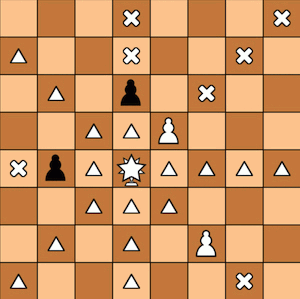
Duchess: it moves as a limited Queen, one, two or three squares in any straight directions. When moving two or three squares, it may jump and it does not matter what any intermediate squares contain. Identical to Terachess-II
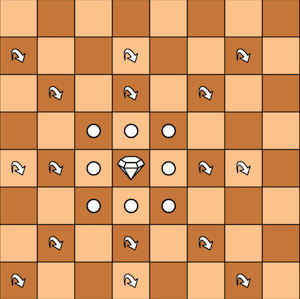
Rules
Pawn, Maasai and Prince Promotion: A Pawn, a Soldier or a Prince reaching the last rank of the board is immediately replaced by a "chief" piece: Queen, Eagle, Lion, Sorceress, Duchess, Rhinoceros or Buffalo. Promotion to any other type of piece is not allowed. It is permitted to promote a Pawn, a Soldier or Prince to a type of piece already present on the same side; however; it is considered "good etiquette" to avoid choosing a piece which is not captured yet, if possible.
En Passant capture: Any time a Pawn or Prince or Soldier takes a double step and passes through the capture square of an opposing Pawn, that Pawn may capture the opposing piece as if it had only moved one square. This en passant capture must be made in the immediate move following the double step. Only a Pawn may capture en passant.
End Of Game: The end-of-game rules, checkmate, stalemate, etc., are identical to standard chess.
Notes
Alternative
An alternative has been tested with Sergeants instead of Soldiers. This version has been abandoned.
Sergeant: a "complete" Pawn, he can move or capture one square straight or diagonally forward. Unlike the Pawn, he cannot make an initial two-square move.

Pieces Value Zillions gives these average values on the line-up, normalized to 5 for the Rook :
Pawn: 0.9 ; Maasai: 1.7 ; Giraffe:2 ; Camel: 2.2 ; Elephant: 2.5 ; Knight: 2.5 ; Machine: 2.9 ; Crocodile: 3.3 ; Bishop: 3.4 ; Prince: 3.6 ; Cannon: 4.9 ; Rook: 5 ; Rhinoceros: 5.9 ; Buffalo: 6.8 ; Duchess: 7.4 ; Lion: 7.8 ; Eagle: 7.7 ; Sorceress: 8 ; Queen: 8.2
A maybe more realistic estimate would be: Pawn: 1 ; Maasai: 1.5; Giraffe: 2 ; Camel: 2 ; Elephant: 2.5 ; Knight: 2.5 ; Machine: 3 ; Prince: 3; Crocodile: 3 ; Bishop: 3.5 ; Cannon: 4 ; Rook: 5 ; Rhinoceros: 6 ; Sorceress: 6.5; Buffalo: 7 ; Duchess: 7.5 ; Lion: 7.5 ; Eagle: 8 ; Queen: 8.5
These values are just given for a very rough estimate. A lot of players would disagree and give less or more points to several piece. Never mind, make your own scale and be the Lord of the Maasai.
 This 'user submitted' page is a collaboration between the posting user and the Chess Variant Pages. Registered contributors to the Chess Variant Pages have the ability to post their own works, subject to review and editing by the Chess Variant Pages Editorial Staff.
This 'user submitted' page is a collaboration between the posting user and the Chess Variant Pages. Registered contributors to the Chess Variant Pages have the ability to post their own works, subject to review and editing by the Chess Variant Pages Editorial Staff.
By Jean-Louis Cazaux.
Last revised by Jean-Louis Cazaux.
Web page created: 2021-05-06. Web page last updated: 2022-11-30
